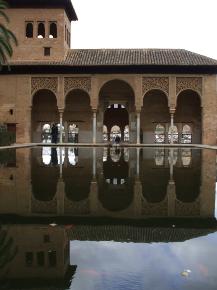Period Band: A/B
Curatorial Rating: unrated
Monuments of the Islamic World: Innovation and Change from Spain to India
Tutor: Richard McClary
Description
This course uses six key monuments from the late medieval and early modern periods, spanning the eastern, central and western Islamic lands, as prisms through which a deeper understanding of a larger corpus of buildings is established. The course addresses two examples from each of the three key structural typologies in Islamic architecture. For palaces; there is a close study of the Alhambra in Granada and the Topkapi Palace in Istanbul. For mosques; the Friday Mosque in Isfahan the Süleymaniye Mosque in Istanbul. Finally, the Ahmed Yasawi Tomb in Turkistan and the Taj Mahal in Agra provide an understanding of the tomb.
Numerous antecedent structures of the six key monuments, along with the construction materials and decorative motifs, will be examined. This will demonstrate the main dynastic styles of the period. There is a particular focus on the aesthetics developed in Ottoman Turkey, Timurid Iran and Mughal India during the fifteenth and sixteenth centuries.
The course starts with a study of theories, approaches and problems concerning the field of Islamic art history. This includes a number of the different scholarly approaches to the material. Attention then moves to the study of buildings constructed from a wide variety of materials, and will give an explanation of how the primary media of construction were combined to create the formal and decorative whole.
By drawing on a wide range of sources, but focusing on six key monuments, students will gain the ability to assess the fluid nature of craftsmen and craft practices, the views of the main scholars in the field, and a sense of the hybridity, diversity and underlying unity of the art and architecture of the Islamic world.
The course will include a field trip (possible locations to include Andalucía, Istanbul or Morocco) to allow for students to engage directly with individual monument and their broader urban setting, as well as museum collections holding elements removed from buildings studied in the course.
This wide-ranging course will be the only one of its type available in the UK, and will give students an excellent foundation for further studies in the field.
Objectives
By the end of the module, students should have acquired:
- an awareness of the scale and the scope of medieval and early modern Islamic architecture.
- a clear understanding of the medieval phase of development and allow them to gain a strong grasp on the key monuments covered in the course.
- the ability to recognize the primary materials and decorative styles of the major dynasties ruling the Islamic world during the period of study.
- the skills to critically analyse the opinions of key scholars in the field, and synthesize differing views regarding the connections between the arts of the various regions of the Islamic world.
- the ability to independently research and present their findings in a public setting.
Preliminary Reading
- Alfieri, B. M. 2000. Islamic Architecture of the Indian Subcontinent, London
- Babaie, S. 2008. Isfahan and Its Palaces: Statecraft, Shi’ism and the Architecture of Conviviality in Early Modern Iran, Edinburgh
- Begley, W. E. and Desai, Z. A. 1989. Taj Mahal: The Illuminated Tomb, London / Seattle, WA
- Blair, S. and Bloom, J. 2004. The Art and Architecture of Islam 1250-1800, London/New Haven, CT
- Fernández-Puertas, A. 2001. The Alhambra: From the Ninth Century to Yūsef I, London
- Grabar, O. 1990. The Great Mosque of Isfahan, New York, NY
- Hillenbrand, R. 1994. Islamic Architecture: Form, Function, Meaning, Edinburgh
- Koch, E. and Barraud, R. A. 2006. The Complete Taj Mahal: And the Riverfront Gardens of Agra, London
- Kuban, D. 2010. Ottoman Architecture, Woodbridge
- Lambah, A. N. and Patel, A. (eds.) 2006. The Architecture of the Indian Sultanates, Mumbai
- Leaman, O. 2004. Islamic Aesthetics: An Introduction, Edinburgh
- Necipoğlu, G. 1991. Architecture, Ceremonial, and Power: The Topkapı Palace in the Fifteenth and Sixteenth Centuries, Cambridge, MA

Module code HOA00054H
